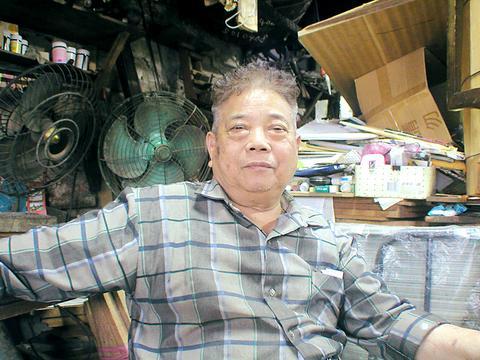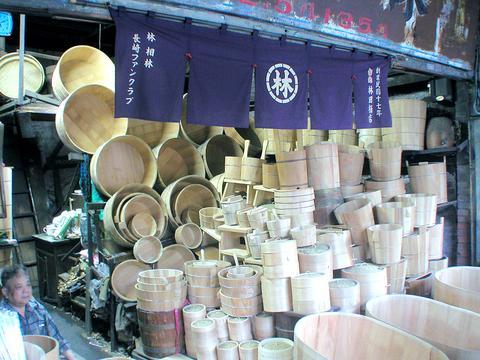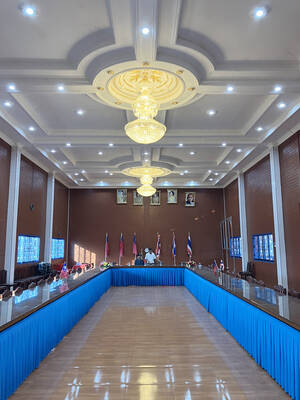With the volume turned up loud enough to be heard over the din of afternoon traffic on Zhongshan North Road in Taipei, two generations of Lin men sat on the floor of their cramped shop on Thursday, watching Japanese variety shows while a trickle of customers, mostly just passersby, would pause at the store's open front to consider the wooden tubs and basins stacked to the ceiling.
Passing pedestrians rarely make impulse purchases of NT$25,000 for a 20kg, hinoki wood bath tub, so the Lins are skilled at sizing up potential customers at a glance and are a bit loathe to indulge random people's curiosity. After 76 years in the business of making the tubs, basins and kitchen utensils at their shop, Lin Tian Tong Dian (

PHOTO: MAX WOODWORTH, TAIPEI TIMES
"It's either old people who grew up during the Japanese occupation and adopted the Japanese bathing tradition, or young people who see it as a quaint relic from long ago and something fun to have around the house," said Lin Huang-yi (

The Lin Tian store, named after its founder, was fomerly one among many hawking similar wares on the block between what is now Civil Boulevard and Changan West Road. The area formerly was an almost exclusively Japanese neighborhood, housing bureaucrats of the colonial administration and their families whose fastidious hygiene habits provided the Lins and others making wooden tubs with a stable business.
Hinoki cedar wood was a major product in the Japanese administration's lumber trade and was extracted almost to the point of extinction, so that now the trees grow only in scattered groves deep in the mountains. The scarcity of the trees, which are protected under the law, accounts for the dear prices customers now pay for the tubs.
"Most people show some form of shock when I tell them the prices. People are used to plastic tubs that cost a fraction of these, so they're definitely not for every-one," Lin Huang-yi said, stressing the word "plastic" with an audible tone of derision.
Every product is made by hand by the father-and-son duo using only wood boards, bamboo pegs and metal wire. The pegs fix the boards in the proper shape, while the braided wire is tightened around the tub to keep it water-tight and to prevent it from
warping.
"Hinoki wood is the best because of its high resistance to water and heat. If you use cheaper woods, it will expand from the heat of the water and then contract, and very quickly the wire will slide down and that will ruin the shape of the whole tub," Lin Huang-yi said. Cheaper woods are also quick to mold in Taiwan's humid climate, he said.
A full-size tub takes about four days to finish -- two days longer than in years past because of the elder Lin Hsiang Lin's (
Though they won't provide details, people's changing habits and rising material costs have made a noticeable impact on the Lins' business. By the time the Japanese left Taiwan in 1945, the workshop was crowded with 15 craftsmen under the direction of Lin Tian, making primarily tubs. Currently, it's just the two Lins and their sales are mostly of the less expensive shallow wash basins and flower pots, which run up to NT$5,000, as well as steamers and rice bowls made of Chinese fir that are sold to local Japanese restaurants.
The steamers are popular because foods prepared in them will have a slight, but noticeable aroma from the wood.
"There used to be three stores lined up here next to each other, but we're the only one left," Lin Huang-yi said. He then quickly declined a chance at self-flattery when he said their products weren't necessarily better than those at other stores. "Maybe we've survived this long because we own this real estate so we don't have to pay rent. If we had to pay rent, I don't think we'd still be around either."
But the tubs and steamers are clearly crafted by experienced hands, and the store's inclusion on Taipei sight-seeing tours, as well as numerous appearances in Japanese media, attest to its status high on the list of the city's remaining traditional craftsmen.
Fame has so far sustained the business, but when asked if the store would continue into the fourth generation, Lin Huang-yi was unsure. "I don't know. It's not out yet," he said.
Lin Tian Tong Store is located at 108 Zhongshan N Rd, Sec 1, Taipei (

May 26 to June 1 When the Qing Dynasty first took control over many parts of Taiwan in 1684, it roughly continued the Kingdom of Tungning’s administrative borders (see below), setting up one prefecture and three counties. The actual area of control covered today’s Chiayi, Tainan and Kaohsiung. The administrative center was in Taiwan Prefecture, in today’s Tainan. But as Han settlement expanded and due to rebellions and other international incidents, the administrative units became more complex. By the time Taiwan became a province of the Qing in 1887, there were three prefectures, eleven counties, three subprefectures and one directly-administered prefecture, with

Taiwan Power Co (Taipower, 台電) and the New Taipei City Government in May last year agreed to allow the activation of a spent fuel storage facility for the Jinshan Nuclear Power Plant in Shihmen District (石門). The deal ended eleven years of legal wrangling. According to the Taipower announcement, the city government engaged in repeated delays, failing to approve water and soil conservation plans. Taipower said at the time that plans for another dry storage facility for the Guosheng Nuclear Power Plant in New Taipei City’s Wanli District (萬里) remained stuck in legal limbo. Later that year an agreement was reached

What does the Taiwan People’s Party (TPP) in the Huang Kuo-chang (黃國昌) era stand for? What sets it apart from their allies, the Chinese Nationalist Party (KMT)? With some shifts in tone and emphasis, the KMT’s stances have not changed significantly since the late 2000s and the era of former president Ma Ying-jeou (馬英九). The Democratic Progressive Party’s (DPP) current platform formed in the mid-2010s under the guidance of Tsai Ing-wen (蔡英文), and current President William Lai (賴清德) campaigned on continuity. Though their ideological stances may be a bit stale, they have the advantage of being broadly understood by the voters.

In a high-rise office building in Taipei’s government district, the primary agency for maintaining links to Thailand’s 108 Yunnan villages — which are home to a population of around 200,000 descendants of the Chinese Nationalist Party (KMT) armies stranded in Thailand following the Chinese Civil War — is the Overseas Community Affairs Council (OCAC). Established in China in 1926, the OCAC was born of a mandate to support Chinese education, culture and economic development in far flung Chinese diaspora communities, which, especially in southeast Asia, had underwritten the military insurgencies against the Qing Dynasty that led to the founding of